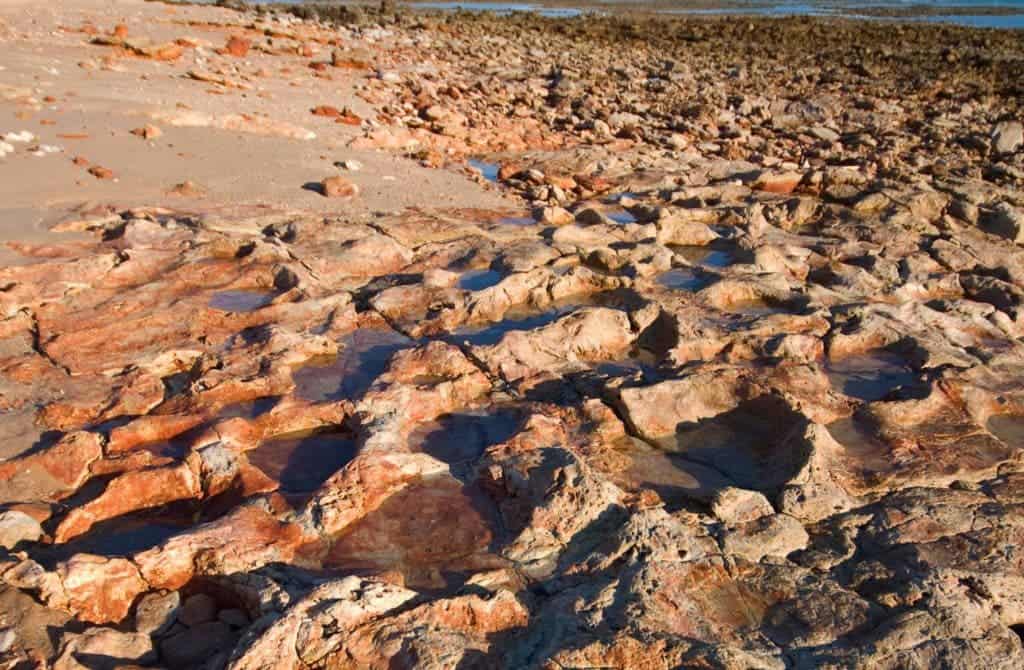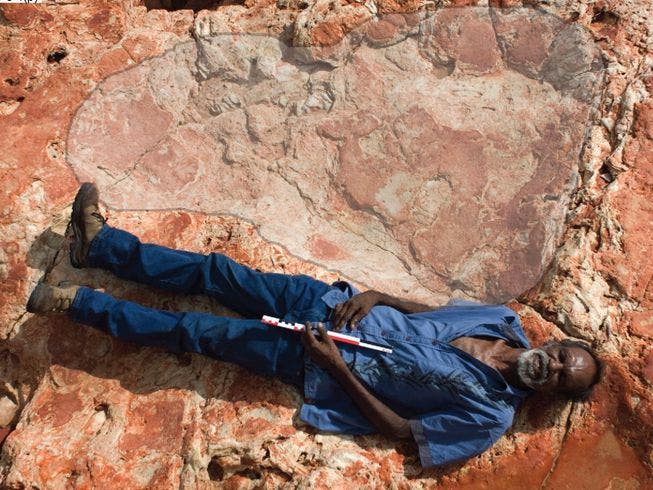
Some of the many dinosaur tracks uncovered at Walmadany area, Western Australia. Image credit: Steve Salisbury.
Paleontologists from the University of Queensland and James Cook University have documented the most diverse assemblage of dinosaur tracks in the world. Thousands of tracks were carefully examined and measured on a 15.5-mile (25 km) stretch of rock on the Dampier Peninsula in Australia’s Kimberley region, etched by all kinds of dinosaurs 140 to 127 million years ago. The size of the prints varied from a couple of inches to a couple of feet. In fact, it’s here that the world’s largest dinosaur print was found, a massive 5 feet 9 inches (1.75 meters) footprint belonging to a sauropod, a long-necked herbivore.
Some 130 million years ago, the Australian landmass looked nothing like the arid Down Under we all know today. At the time, the landmass had just separated from Gondwana, the massive supercontinent that used to also connect Antarctica, India, South America, and Africa. Conifer forests covered much of Australia, along with smaller plants like ferns and gingkoes. Summers and winters were more pronounced although the temperature never dropped below freezing. These sort of environmental conditions must have made Dampier Peninsula an ideal landscape for dinosaurs.
The dino tracks from Dampier Peninsula documented by Dr. Steve Salisbury and other paleontologists at the University of Queensland were made alongside what was then a vast ancient river plain that opened into a belt of tidal deltas and estuaries, crisscrossed by channels and creeks. Cycad fossils, which were the dominant plants during the Mesozoic, the age of the dinosaurs, offered clues to what kind of ancient plants existed there.
“It is extremely significant, forming the primary record of non-avian dinosaurs in the western half the continent and providing the only glimpse of Australia’s dinosaur fauna during the first half of the Early Cretaceous Period,” Salisbury said.
“It’s such a magical place — Australia’s own Jurassic Park, in a spectacular wilderness setting.”
You might wonder how something as fragile as a footprint can get preserved for over a hundred million years. Briefly, it’s 10% having the right conditions and 90% pure luck. As the dinosaurs stepped on the soft muddy sediments, they left indentations which became covered in a blanket of dry sediments which gradually accumulated. Thanks to lithification, which is the compaction and bonding of sediments through chemical and mineral reactions, these footprints etched in the sediments became hardened. Finally, the sediments eventually turned into rock and the tracks became preserved in nearly horizontal layers of sandstone and siltstones at the Broome Sandstone formation. Dr. Salisbury notes that in some places even ‘rippled’ sandstone, which shows the direction water used to move, was preserved in the same formation.
Eventually, erosion and weathering blew away the layer of sediment covering the fossil tracks to reveal the indentation of the original footprints. Of course, it wasn’t scientists who first discovered them but the Aboriginals of the Dampier Peninsula and greater west Kimberley, for whom such tracks are part of their cultural heritage.
“The tracks are integral to a ‘song cycle’ that extends along the coast from Bunginygun to Wabana then inland to the southeast over a total distance of approximately 280 miles (450 km), tracing the journey of a Dreamtime creator being known as Marala, or ‘Emu Man’.”
“These trackways are of international significance,” Dr. Salisbury added.
“The glimpse of a 130-million-year-old world that they provide is awe inspiring. But it is the linking of these track sites into the songline and associated indigenous culture that adds a whole other dimension to their significance.”
This must have been a very welcoming place judging from the richness and variety of dinosaur footprints, which Salisbury likens it to the ‘Cretaceous equivalent of the Serengeti’. Of the many tracks found here, 150 can be assigned to 21 specific track types representing four main groups of dinosaurs: theropods, sauropods, ornithopods and thyreophorans. Among these tracks, for instance, is the only confirmed evidence of stegosaurus.
“There are also some of the largest dinosaur tracks ever recorded. Some of the sauropod tracks are around 1.7 m long.”

This sauropod footprint is among the largest in the world if not the largest. As you can notice, it was big enough to cover a grown man. Credit: Salisbury et al, Journal of Vertebrate Paleontology.
Well, it’s nice to know sauropods were vegetarians at least. And what a sight it must have been seeing this giant, family alongside, flanked by small and medium-sized dinosaurs, all looking to have a drink or chow down on the lush delta vegetation — with some predators lurking of course.
The tracks were documented in the Journal of Vertebrate Paleontology.









